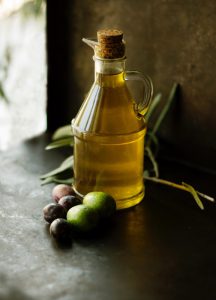 Welcome to our next installment of FSHN Research Journeys, which follows the research of graduate students in the Food Science and Human Nutrition program at UF. Today’s guest poster is Melissa Moreno, a first-year graduate student earning her master’s degree in nutritional sciences. Read on to learn about the devastating effects of trigeminal neuralgia and how olive oil may offer a gentle approach to treating facial pain.
Welcome to our next installment of FSHN Research Journeys, which follows the research of graduate students in the Food Science and Human Nutrition program at UF. Today’s guest poster is Melissa Moreno, a first-year graduate student earning her master’s degree in nutritional sciences. Read on to learn about the devastating effects of trigeminal neuralgia and how olive oil may offer a gentle approach to treating facial pain.
Melissa: My first experience grasping the burden of severe facial pain was at a dentist appointment. The hygienist was curious about my thesis project on trigeminal neuralgia (TN). Although my research is centered around TN, at the time I had only read about the disease. The hygienist told me about some of her patients with TN. I began to understand the colloquial name for TN – “the suicide disease” – as she described how the slightest touch could cause intense pain.
What is Trigeminal Neuralgia?
Trigeminal neuralgia (TN) is a chronic disease characterized by degradation in the function of the trigeminal nerve which transmits sensations to the face. Degradation can be a result of compression of the nerve due to a tumor or from damage to the myelin sheath, which is the protective coating around nerves.
Annually, around 150,000 people are diagnosed with TN, and women are affected more than men.1 Stimuli such as brushing teeth can trigger a flare-up of trigeminal neuralgia. As patients describe, the pain is an intense, stabbing sensation primarily in the lower jaw but can be felt in the whole face. Each patient’s symptoms are unique. Because of the excruciating pain experienced, patients exhibit higher rates of depression, anxiety, and suicidal thoughts.

Melissa’s Inspiration to Study an Alternative Therapy for TN
After obtaining an undergraduate background in nutrition, I decided to pursue a nutrition graduate degree. I chose UF because not only am I familiar with the university, but also UF is one of the top schools in the US. Having family support nearby made it even more attractive to continue my education at UF.
When I met with my advisor, Dr. Wendy Dahl, we discussed TN and how trigeminal neuralgia type 1 is due to the lack of myelin around the trigeminal nerve. We discussed how nutrition is the foundation of health, and what we consume makes up the building blocks of our bodies. I began to understand how the foods we eat influence every mechanism in our body, potentially even the production of myelin.
Like other membranes in our bodies, myelin contains high levels of lipids, which are required for myelin formation.2 This fact suggests a connection between nutrition and myelin formation. In my research project, I hope to study the effects of diet on TN pain. My interest in this study signifies my determination to investigate nutrition techniques to help treat, prevent, and even cure multiple diseases.
How Olive Oil May Transform Therapy for TN
TN patients have the option of either surgical procedures, which are up to 80% successful, or prescription pain medications, which can lead to complications such as liver damage. An adjunctive treatment for this disease may give patients a better chance at a pain-free life, especially if combined with existing treatments. From my discussions with TN sufferers, they have indicated a strong desire for natural therapies due to the side effects of medications given.
Previous studies have examined the impact of a high-fat diet on myelin in rats. One of these studies, conducted at UF, showed that a high-fat diet favorably impacts myelin by maintenance and restoration.3 If we see similar results in humans, then dietary intervention may decrease TN pain, increasing quality of life. My research study will be the first human clinical trial on TN with a high olive oil intervention. Participants are ecstatic. Talking with them, you can feel their excitement for a study on their condition.

The Mediterranean Diet and Melissa’s Research Goals
The purpose of my study is to determine the feasibility of daily intake of olive oil and its potential to alleviate facial pain. Specifically, can participants incorporate four tablespoons of olive oil into their diet? Once I determine this feasibility, I will study whether olive oil decreases participants’ facial pain.
The daily amount of olive oil was chosen because it is consistent with high olive oil diets such as the Mediterranean Diet. Dietary changes will be assessed at the baseline, midpoint, and end of study periods. There is a slight concern regarding weight gain for those in the olive oil group. However, we will give recipes containing olive oil to the participants to aid in making calorically equal meals. My goal is to determine that daily consumption of olive oil is attainable and that participants experienced fewer TN symptoms.
Testing Olive Oil: The Next Steps

In this study, participants complete a daily questionnaire measuring pain levels for the duration of the 16-week study. During the first four weeks, participants do not change their diets. After four weeks, we will split participants into a control and an olive oil group. For the next 12 weeks, the olive oil group will consume olive oil. Some challenges that may occur include participants not completing the questionnaires, not consuming the right amount of olive oil, or withdrawing from the study, leading to difficulty acquiring accurate data.
Knowing the extreme pain TN sufferers experience, finding a natural therapy would be life-changing. I can’t wait for my next visit to the dentist so that I can share the latest results of my research into relieving TN pain.
Melissa Moreno is from Ocala, Florida. Before starting her graduate program at UF in nutritional sciences, Melissa completed her undergraduate degree at UF where she double majored in biology and nutritional sciences. Some of her hobbies are baking and exploring nature.

References:
- Pilitsis, J., & Khazen, O. (2021). Trigeminal Neuralgia – Causes, Symptoms and Treatments. Retrieved 26 October 2021, from https://www.aans.org/Patients/Neurosurgical-Conditions-and-Treatments/Trigeminal-Neuralgia
- Jackman, N., Ishii, A., & Bansal, R. (2009). Oligodendrocyte development and myelin biogenesis: parsing out the roles of glycosphingolipids. Physiology, 24(5), 290-297.
- Zhou, Y., Bazick, H., Miles, J. R., Fethiere, A. I., Salihi, M. O. A., Fazio, S., . . . Notterpek, L. (2019). A neutral lipid-enriched diet improves myelination and alleviates peripheral nerve pathology in neuropathic mice. Exp Neurol, 321, 113031. doi:10.1016/j.expneurol.2019.113031
For more information about Trigeminal Neuralgia and the research regarding the disease, check out the following links:
Trigeminal Neuralgia Information Page | National Institute of Neurological Disorders and Stroke (nih.gov)
Trigeminal Neuralgia – StatPearls – NCBI Bookshelf (nih.gov)
The Facial Pain Research Foundation – it’s time to find a cure! (facingfacialpain.org)
 9
9
